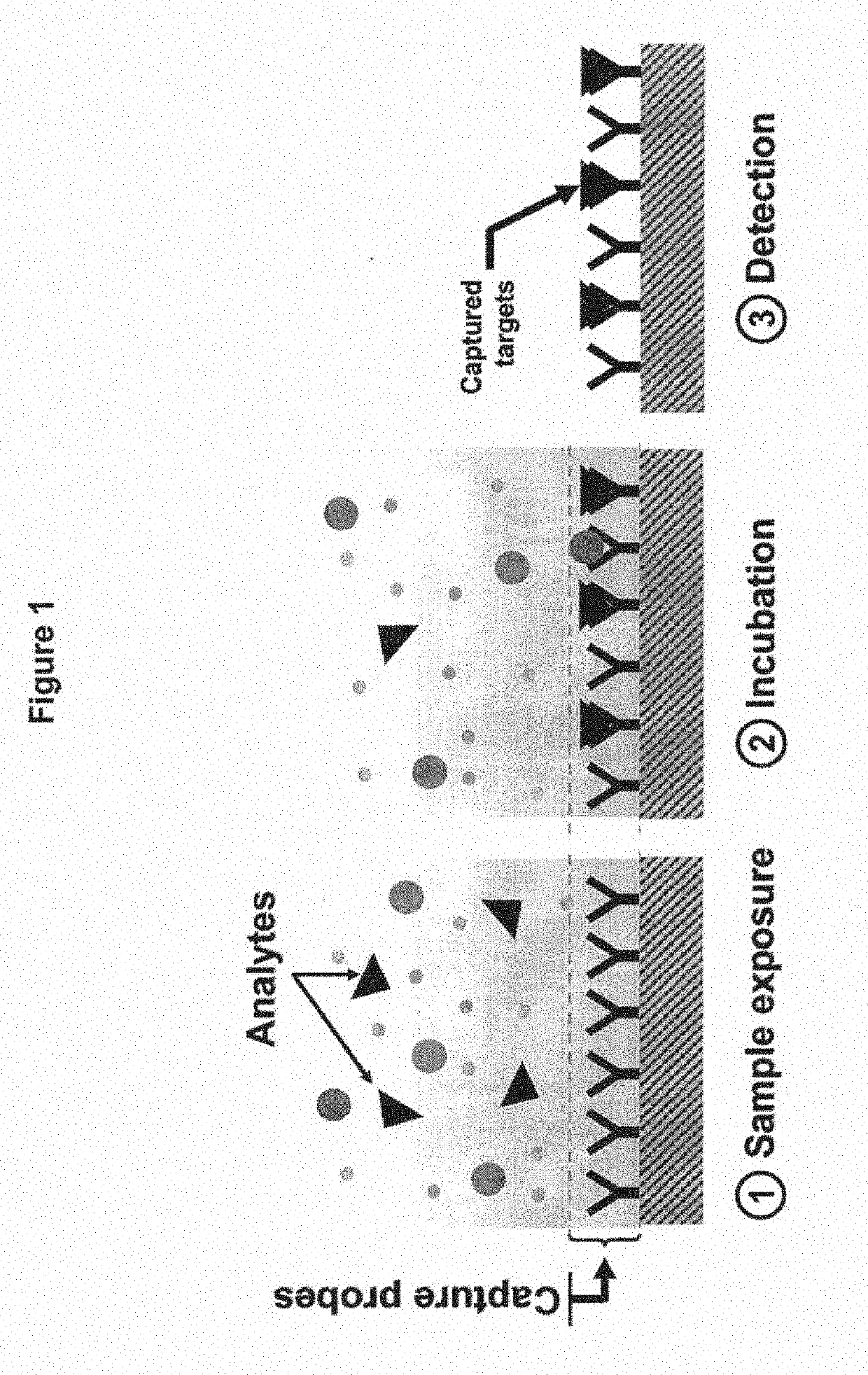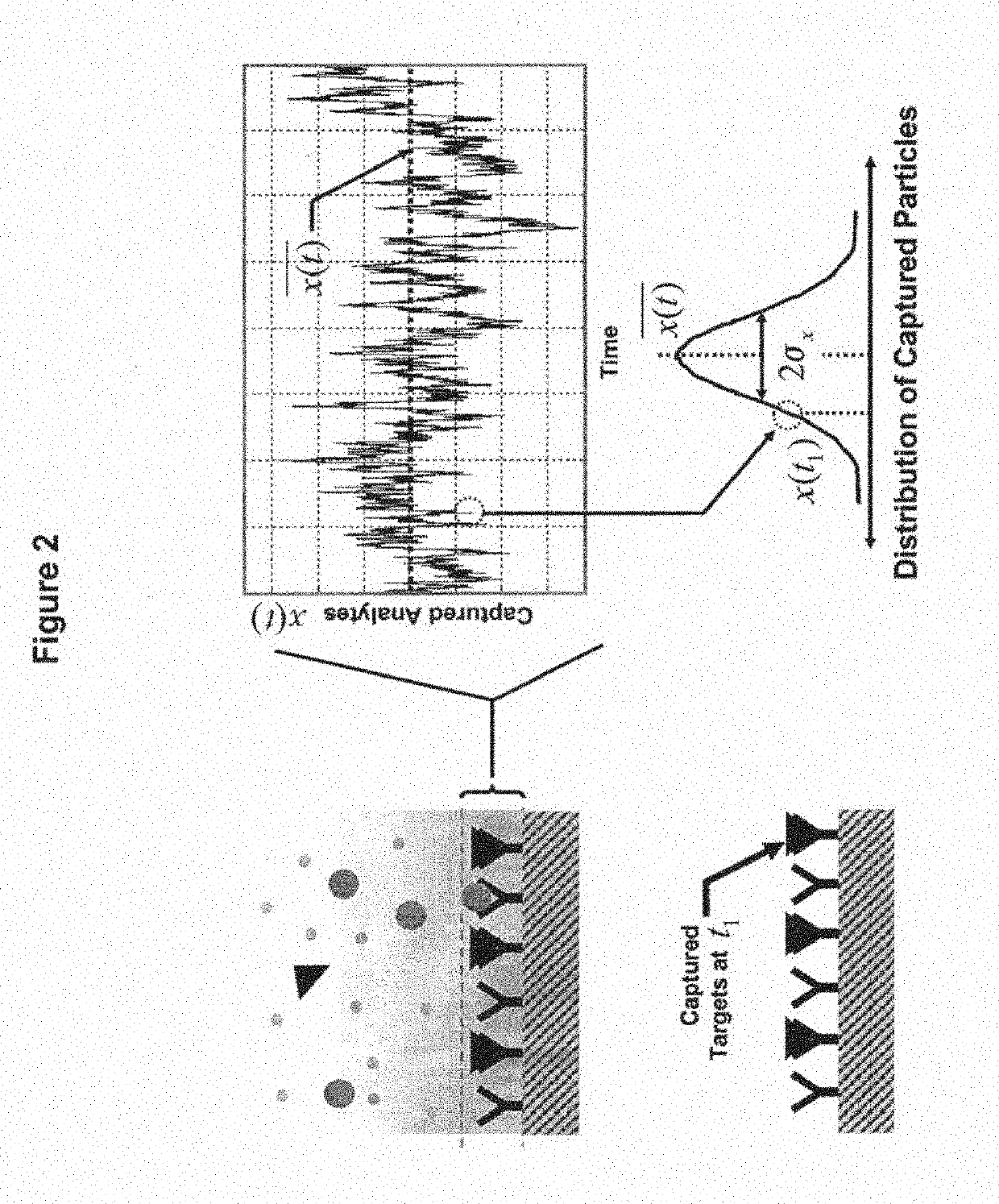Multiplex q-pcr arrays
a technology of q-pcr arrays and arrays, applied in the field of multi-dimensional q-pcr arrays, can solve the problems of affecting the replication process, the limited number of different nucleic acid sequences that can be simultaneously amplified and detected, etc., and achieve the effect of suppressing the effects of cross-hybridization
- Summary
- Abstract
- Description
- Claims
- Application Information
AI Technical Summary
Benefits of technology
Problems solved by technology
Method used
Image
Examples
example 1
[0412]This example demonstrates the use of a sample real-time microarray to measure the binding of multiple analytes to multiple probes.
[0413]FIG. 10 shows the layout of a 6×6 DNA microarray. Three different DNA probes (1, 2, and Control) with three different concentrations (2 μM, 10 μM, and 20 μM) are spotted and immobilized on the surface as illustrated. The probes contain a single Cy3 fluorescent molecule at the 5′ end. The DNA targets in this experiment contain a quencher molecule. The analyte binding in this system results in quenching of fluorescent molecules in certain spots. FIG. 11 shows a few samples of the real-time measurements of the microarray experiment wherein the control targets are added to the system. As illustrated in FIG. 11, the spots are quenched due to analyte binding.
[0414]FIGS. 12-15 each show data for 4 different spots with similar oligonucleotide capturing probes. The target DNA analyte is introduced in the system at time zero and quenching (reduction of ...
example 2
[0416]This example provides a derivation of an algorithm, and the use of the algorithm to determine analyte concentration such as amplicon concentration, from a real-time binding data. The derivation proceeds as follows:
[0417]Assume that the hybridization process starts at t=0, and consider discrete time intervals of the length Δt. Consider the change in the number of bound target molecules during the time interval (iΔt, (i+1)Δt). We can write
nb(i+1)−nb(i)=[nt−nb(i)]pb(i)Δt−nb(i)pr(i)Δt, [0418]where nt denotes the total number of target molecules, nb(i) and nb(i+1) are the numbers of bound target molecules at t=iΔt and t=(i+1)Δt, respectively, and where pb(i) and pr(i) denote the probabilities of a target molecule binding to and releasing from a capturing probe during the ith time interval, respectively. Hence,
nb(i+1)-nb(i)Δt=[nt-nb(i)]pb(i)-nb(i)pr(i).(1)
[0419]It is reasonable to assume that the probability of the target release does not change between time intervals, i.e., pr(i)=p...
example 3
[0443]This example shows how the methods and systems of the present disclosure can be used for measurement of gene expression. Real-time microarray technology can measure, for example, expression level differences for different cell types or tissues, distinct developmental stages, cancerous versus normal cells or tissues, treated versus untreated cells or tissues, mutant versus wild-type cells, tissues or organisms.
[0444]The gene expression profiles of inflorescences of the Arabidopsis thaliana floral homeotic mutants apetala1, apetala2, apetala3, pistillata, and agamous can be compared with that of wild-type plants. By combining the data sets from the individual mutant / wild type comparisons, it is possible to identify a large number of genes that are, within flowers, predicted to be specifically or at least predominantly expressed in one type of floral organ. For each sample, floral buds from approximately 50 plants are collected, and RNA is isolated from 100 mg of tissue with the ...
PUM
| Property | Measurement | Unit |
|---|---|---|
| roughness | aaaaa | aaaaa |
| roughness | aaaaa | aaaaa |
| roughness | aaaaa | aaaaa |
Abstract
Description
Claims
Application Information
 Login to View More
Login to View More - R&D
- Intellectual Property
- Life Sciences
- Materials
- Tech Scout
- Unparalleled Data Quality
- Higher Quality Content
- 60% Fewer Hallucinations
Browse by: Latest US Patents, China's latest patents, Technical Efficacy Thesaurus, Application Domain, Technology Topic, Popular Technical Reports.
© 2025 PatSnap. All rights reserved.Legal|Privacy policy|Modern Slavery Act Transparency Statement|Sitemap|About US| Contact US: help@patsnap.com



